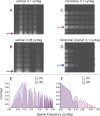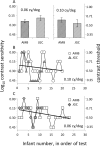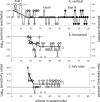The contrast sensitivity of the newborn human infant
- PMID: 25564453
- PMCID: PMC4309312
- DOI: 10.1167/iovs.14-14757
The contrast sensitivity of the newborn human infant
Abstract
Purpose: To measure the binocular contrast sensitivity (CS) of newborn infants using a fixation-and-following card procedure.
Methods: The CS of 119 healthy newborn infants was measured using stimuli printed on cards under the descending method of limits (93 infants) and randomized/masked designs (26 infants). One experienced and one novice adult observer tested the infants using vertical square-wave gratings (0.06 and 0.10 cyc/deg; 20/10,000 and 20/6000 nominal Snellen equivalent); the experienced observer also tested using horizontal gratings (0.10 cyc/deg) and using the Method of Constant Stimuli while being kept unaware of the stimulus values.
Results: The CS of the newborn infant was 2.0 (contrast threshold = 0.497; 95% confidence interval: 0.475-0.524) for vertically oriented gratings and 1.74 (threshold = 0.575; 95% confidence interval: 0.523-0.633) for horizontally oriented gratings (P < 0.0006). The standard deviation of infant CS was comparable to that obtained by others on adults using the Pelli-Robson chart. The two observers showed similar practice effects. Randomization of stimulus order and masking of the adult observer had no effect on CS.
Conclusions: The CS of individual newborn human infants can be measured using a fixation-and-following card procedure.
Keywords: card procedure; contrast sensitivity; fixation-and-following; neonatal; newborn.
Copyright 2015 The Association for Research in Vision and Ophthalmology, Inc.
Figures








References
-
- Brodsky MC. The apparently blind infant. In: Brodsky MC. ed Pediatric Neuro-ophthalmology. New York: Springer; 2010: 1–58.
-
- Robson JG. Spatial and temporal contrast sensitivity functions of the visual system. J Opt Soc Am. 1966; 56: 1141–11 42.
Publication types
MeSH terms
Grants and funding
LinkOut - more resources
Full Text Sources
Other Literature Sources

